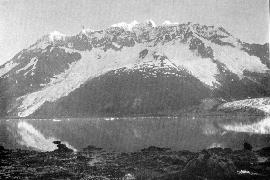the john muir exhibit - writings - travels_in_alaska - preface
Travels in Alaska
by John Muir
Preface

Alpenglow on Summit of Mt. Muir,
Harrison Fiord, Prince William Sound
|
Forty years ago John Muir wrote to a friend; "I am hopelessly
and forever a mountaineer. . . . Civilization and fever, and all
the morbidness that has been hooted at me, have not dimmed my
glacial eyes, and I care to live only to entice people to look
at Nature's loveliness." How gloriously he fulfilled the
promise of his early manhood! Fame, all unbidden, wore a path
to his door, but he always remained a modest, unspoiled mountaineer.
Kindred spirits, the greatest of his time, sought him out, even
in his mountain cabin, and felt honored by his friendship. Ralph
Waldo Emerson urged him to visit Concord and rest awhile from
the strain of his solitary studies in the Sierra Nevada. But nothing
could dislodge him from the glacial problems of the high Sierra;
with passionate interest he kept at his task. "The grandeur
of these forces and their glorious results," he once wrote,
"overpower me and inhabit my whole being. Waking or sleeping,
I have no rest. In dreams I read blurred sheets of glacial writing,
or follow lines of cleavage, or struggle with the difficulties
of some extraordinary rock-form."
There is a note of pathos, the echo of an unfulfilled hope, in
the record of his later visit to Concord. "It was seventeen
years after our parting on Wawona ridge that I stood beside his
[Emerson's] grave under
a pine tree on the hill above Sleepy
Hollow. He had gone to higher Sierras, and, as I fancied, was
again waving his hand in friendly recognition." And now John
Muir has followed his friend of other days to the "higher
Sierras." His earthly remains lie among trees planted by
his own hand. To the pine tree of Sleepy Hollow answers a guardian
sequoia in the sunny Alhambra Valley.
In 1879 John Muir went to Alaska for the first time. Its stupendous
living glaciers aroused his unbounded interest, for they enabled
him to verify his theories of glacial action. Again and again
he returned to this continental laboratory of landscapes. The
greatest of the tide-water glaciers appropriately commemorates
his name. Upon this book of Alaska travels, all but finished before
his unforeseen departure, John Muir expended the last months of
his life. It was begun soon after his return from Africa in 1912.
His eager leadership of the ill-fated campaign to save his
beloved Hetch-Hetchy Valley from commercial destruction seriously
interrupted his labors. Illness, also, interposed some checks
as he worked with characteristic care and thoroughness through
the great mass of Alaska notes that had accumulated under his
hands for more than thirty years.
The events recorded in this volume end in the middle of the trip
of 1890. Muir's notes on the remainder of the journey have not
been found, and it is idle to speculate how he would have concluded
the volume if he had lived to complete it. But no one will read
the fascinating description of the Northern
Lights without
feeling a poetical appropriateness in the fact that his last work
ends with a portrayal of the auroras--one of those phenomena which
else where he described as "the most glorious of all the
terrestrial manifestations of God."
Muir's manuscripts bear on every page impressive evidence of the
pains he took in his literary work, and the lofty standard he
set himself in his scientific studies. The counterfeiting of a
fact or of an experience was a thing unthinkable in connection
with John Muir. He was tireless in pursuing the meaning of a physiographical
fact, and his extraordinary physical endurance usually enabled
him to trail it to its last hiding-place. Often, when telling
the tale of his adventures in Alaska, his eyes would kindle with
youthful enthusiasm, and he would live over again the red-blooded
years that yielded him "shapeless harvests of revealed glory."
For a number of months just prior to his death he had the friendly
assistance of Mrs. Marion Randall Parsons. Her familiarity with
the manuscript, and with Mr. Muir's expressed and penciled intentions
of revision and arrangement, made her the logical
person to prepare it in final form for publication. It was a task
to which she brought devotion as well as ability. The labor involved
was the greater in order that the finished work might exhibit
the last touches of Muir's master-hand, and yet contain nothing
that did not flow from his pen. All readers of this book will
feel grateful for her labor of love.
I add these prefatory lines to the work of my departed
friend
with pensive misgiving, knowing that he would have deprecated
any discharge of musketry over his grave. His daughters, Mrs.
Thomas Rea Hanna and Mrs. Buel Alvin Funk, have honored me with
the request to transmit the manuscript for publication, and later
to consider with them what salvage may be made from among their
father's unpublished writings. They also wish me to express their
grateful acknowledgments to Houghton Mifflin Company, with whom
John Muir has always maintained close and friendly relations.
William Frederic Badè.
Berkeley, California,
May, 1915.
[
Map of John Muir's Travels in Alaska
|
Forward to Chapter 1
|
Table of Contents
]